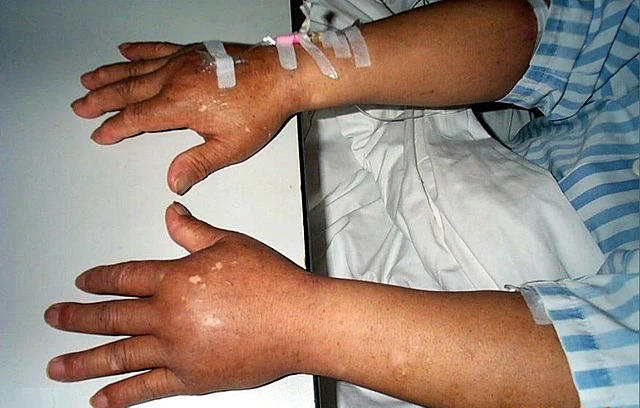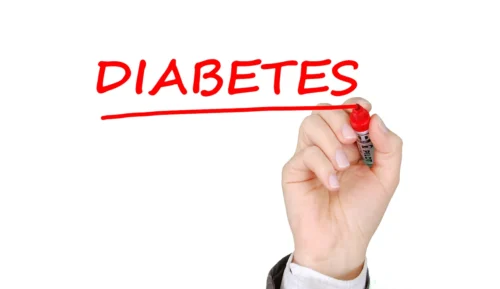This post may contain affiliate links and ads in which we may earn a small percentage of purchases.
Edema occurs when fluid leaks from cells in your body and accumulates in the surrounding tissues1. This can be due to a variety of factors, including medical conditions, medication side effects, or even lifestyle factors like prolonged standing or sitting.
Quick Links
What is Edema?
Edema means swelling2. is a condition characterized by an excess of fluid trapped in the body’s tissues, leading to swelling. It can occur in various parts of the body, but it is most commonly observed in the extremities such as the legs, ankles, and feet. Edema can be categorized into two types: pitting and non-pitting. Understanding the differences between these two types is crucial for accurate diagnosis and effective treatment.
Early signs of edema include the following:3
- An arm or leg feels heavy and puffy.
- The arm or leg looks swollen.
- When you press the swelling, it leaves a dent.
- Your clothing or jewelry feels tight and uncomfortable.
- The skin around the edema feels warm and tight.
- It becomes harder to move any joints that are affected.
- The affected area starts to feel tight and may be painful.

Causes
- Lymphedema: This occurs when the lymphatic system is damaged or blocked, leading to fluid buildup in the tissues.
- Thyroid disease: Conditions such as hypothyroidism can cause edema, particularly around the eyes and face.
- Infections and inflammation: Certain infections or inflammatory conditions can cause edema in the affected area.
- Localized trauma: Injury or surgery can lead to non-pitting edema in the affected area.
- Heart failure: When the heart is unable to pump blood effectively, fluid can accumulate in the extremities.
- Chronic venous insufficiency: Poor functioning of the veins, especially in the legs, can lead to fluid buildup.
- Kidney disease: Impaired kidney function can result in fluid retention and edema.
- Low protein levels in the blood: Caused by a lack of protein albumin in the blood4.
- Liver disease: Conditions like cirrhosis can disrupt normal fluid balance in the body.
- Medications: Certain medications, such as those for high blood pressure or corticosteroids, can cause edema.
Pitting Edema
Definition
Pitting edema is characterized by a visible and palpable indentation that remains in the skin after pressure is applied and then released. This indentation, or “pit,” typically persists for some time before the skin slowly returns to its normal state.
Treatment
Treatment of pitting edema focuses on addressing the underlying cause. Common approaches include:
- Medications: Diuretics can help reduce fluid retention.
- Lifestyle changes: Elevating the affected limbs, wearing compression stockings, reducing salt intake, and engaging in regular physical activity can help manage symptoms.
- Treating the underlying condition: Managing heart, kidney, or liver disease can reduce edema.
Non-Pitting Edema
Definition
Non-pitting edema is characterized by swelling that does not leave an indentation when pressure is applied. The skin may feel firm or tight, and the swollen area typically appears shiny.
Non-pitting edema is often associated with conditions that cause fluid to accumulate in the tissues rather than in the spaces between them. Common causes include:
Treatment
Treatment for non-pitting edema also focuses on addressing the underlying cause and may include:
- Compression therapy: Using compression garments to improve lymphatic drainage.
- Manual lymphatic drainage: A specialized massage technique to encourage the movement of lymph fluid.
- Exercise: Physical activity can help improve lymphatic flow and reduce swelling.
- Medications: Depending on the underlying cause, medications such as thyroid hormone replacement or anti-inflammatory drugs may be prescribed.
Complications of Untreated Edema
If edema is left untreated, it can lead to several complications, including:
- Skin ulcers: Prolonged swelling can cause the skin to break down, leading to ulcers and sores.
- Increased risk of infection: Swollen tissues are more prone to infections, such as cellulitis.
- Reduced mobility: Severe edema can make it difficult to move joints, leading to decreased mobility and physical activity.
- Chronic pain: Persistent swelling can cause discomfort and pain, affecting quality of life.

Patient Education
Educating patients about managing edema is crucial for effective treatment. Here are some self-care measures patients can take at home:
- Elevate the affected limbs: Raise your legs or arms above the level of your heart several times a day to reduce swelling.
- Wear compression stockings: These can help prevent fluid buildup in the extremities.
- Stay active: Engage in regular physical activity to promote circulation and prevent fluid accumulation.
- Monitor your salt intake: Reducing salt in your diet can help decrease fluid retention.
- Stay hydrated: Drinking plenty of water helps maintain a healthy fluid balance in your body.
Monitoring and Follow-Up
Regular monitoring and follow-up appointments with healthcare providers are essential for managing edema effectively. Patients should:
- Track symptoms: Keep a journal of your symptoms, noting any changes in swelling, pain, or mobility.
- Schedule regular check-ups: Regular visits to your healthcare provider can help monitor the progress of your treatment and make necessary adjustments.
- Report any new symptoms: Inform your healthcare provider of any new or worsening symptoms, such as increased swelling, pain, or signs of infection.
- Retrieved June 18th, 2024 from https://www.cancer.gov/publications/dictionaries/cancer-terms/def/edema ↩︎
- InformedHealth.org [Internet]. Cologne, Germany: Institute for Quality and Efficiency in Health Care (IQWiG); 2006-. In brief: Causes and signs of edema. [Updated 2022 Apr 25]. Retrieved June 17th, 2024 from: https://www.ncbi.nlm.nih.gov/books/NBK279409/ ↩︎
- ↩︎
- ↩︎
Medical Disclaimer: This article is for informational and educational purposes only and is not a substitute for professional medical advice, diagnosis, or treatment. Always consult a qualified healthcare provider with any questions about a medical condition or treatment.





